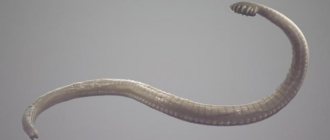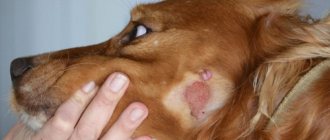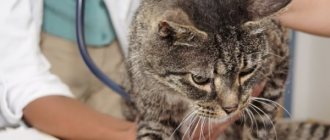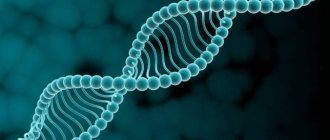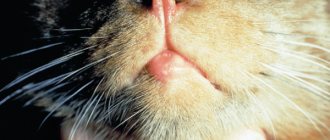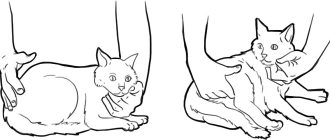Why is it developing?
Spondylosis occurs extremely rarely in kittens; it is often diagnosed in older cats. This disease is characterized by degenerative-dystrophic processes that develop as a result of aging, overload and injury to the spinal column. In addition, discopathy can also develop due to the genetic characteristics of a particular cat breed. For example, the Kurilian Bobtail has a short tail, due to which it has disturbances in the sacral spine.
These signs can trigger discospondylitis and other problems associated with intervertebral discs. If a pet has been diagnosed with rickets, the possibility of impaired disc flexibility cannot be ruled out. Subsequent growth of the kitten can cause deformation and protrusion of the fibrocartilaginous formation.
Reasons for development
Statistics show that this disease is extremely rare in cats; it is mainly characteristic of cats. The disease is an age-related disorder, therefore it is observed in older animals, but sometimes it can also occur in young animals who did not receive enough vitamins, microelements and nutrients during the growth period.
In kittens it forms during rickets, which subsequently leads to deformation and protrusion.
It also happens that discopathy in cats is a complication of infectious diseases in which the tissue of the intervertebral discs becomes inflamed and hardens.
In addition, experienced breeders are aware that representatives of some breeds (Kurilian Bob-Tail, for example) have a genetic predisposition to discopathy.
INTERESTING TO KNOW: Problems with eye suppuration in cats
And finally, one of the most common causes of destructive changes in the intervertebral discs are injuries to the spinal column associated with bruises and jumping from great heights.
Diseases of the nervous system of cats
Diseases of the central nervous system of cats are very diverse and can be caused either by direct damage to the nervous tissue itself or as a consequence of some systemic lesions. Such as hepatitis or hormonal disorders.
Aggression
The most common and frequent symptom of many neurological diseases. A behavioral disorder that can be a completely normal condition during periods of “hunting,” pregnancy or lactation. This problem is solved by hormonal therapy or sterilization. In most cases, periods of aggression pass on their own without medical help. But the aggressiveness of cats may be a consequence of any disease, infection in particular. You should be especially wary if the cat's behavior has changed suddenly. This often speaks in favor of rabies. During this period, it is necessary to protect all family members from possible scratches and bites, and create a calm environment around the pet. If these measures do not help, you should immediately contact your veterinarian.
Discopathy in dogs: symptoms and treatment at home
The sooner discopathy is diagnosed in a four-legged pet, the greater the chance of complete healing. But what is this terrible diagnosis of “discopathy”? How not to miss the disease and notice its symptoms in time?
The dog experiences discomfort while walking.
Discopathy leads to disruption of intervertebral tissues in dogs. Disks stop performing their functions. They become inelastic and lose their shock-absorbing abilities.
The diagnosis can be made by identifying deviations in the functions of the musculoskeletal system. In animals, the mobility of the limbs may be limited, and the flexibility of the vertebrae may be impaired. The animal experiences discomfort and pain while walking or running for a walk.
Risk group
Dachshunds are at risk.
Identify signs of discopathy in dogs of all breeds.
Dachshunds and Pekingese, as well as other small breeds, are considered the most susceptible to this disease. In dachshunds, the diagnosis of discopathy is made in more than 50% of cases.
Small breed dogs are more susceptible to the disease.
Degenerative processes in intervertebral discs occur against the background of age-related disorders of water-salt metabolism.
In this case, an important component of the intervertebral disc, the fibrous ring, is destroyed. The spinal cord begins to experience discomfort from external pressure. Its functioning is disrupted, it swells and the conductivity of nerve fibers changes. Nerve cells, due to impaired blood circulation, experience a lack of oxygen, then they die.
We invite you to familiarize yourself with: Turtle: its habits, lifestyle, habitats, videos, photos
If your pet is overweight, the problem gets worse. Weakness or even paralysis of the limbs may occur, or the dog may lose control over urination and defecation.
The problem begins to get worse if the dog is overweight.
Large breeds
Large breeds of dogs also suffer from manifestations of discopathy, but the process does not occur so quickly and is mild.
In large breeds, the manifestation of the disease is lameness.
Usually the fibrous ring is not completely destroyed, but it is pressed into the spinal canal. Pressure on the spinal cord leads to partial impairment of nerve functions. You can notice the problem by the lameness of the animal, the heaviness when climbing flights of stairs. The dog is reluctant to overcome obstacles by jumping and tries to get around such obstacles.
The initial stage of the disease goes unnoticed. The dog owner may not notice any symptoms for a long time.
- When the process goes far and stiffness of movement appears, it turns out that the disc has already partially lost its shock-absorbing capabilities and has become rigid.
- It is at the stage of stiffness of movements during play walks that it is necessary to quickly show your pet to the veterinarian.
- Progression leads to dysfunction of the spinal cord.
During this period, the symptoms become clearly visible:
- While moving, the dog stops moving its limbs normally, and a shuffling old man’s gait appears. There may be uncertainty in movements. It all depends on the location of the problem disk.
- Reflexes are impaired. The dog may lose control of urination and excretion.
- Sensitivity in the limbs is lost.
- With severe swelling of the spinal cord, the paws completely fail. The animal cannot get up and stand on its own.
A dog loses feeling in its paws when there is severe swelling of the spinal cord.
Symptoms of the problem increase gradually as the disease progresses. Therefore, it is very important to provide timely assistance to your pet at the first sign of a problem. If the disease is left to take its course, the animal becomes disabled or dies.
At the first suspicion of discopathy, you must immediately make an appointment with a veterinarian. If the intervertebral disc is not yet completely deformed, your pet's disability can be avoided.
When visiting a veterinary clinic, your pet will undergo a series of examinations. At the first appointment, the veterinarian will examine the animal and conduct a neurological examination. In order to prescribe adequate treatment, it is necessary to identify the degree of abnormalities in the functioning of the nervous system.
The doctor evaluates:
- The pet’s ability to move without the owner’s help, jump, move up stairs, and move actively.
- Reflexes will be checked; the response will allow the doctor to assess the extent of brain damage.
- The sensitivity of the limbs is checked with a clamp, which is applied to the interphalangeal skin space. In a normal state, the dog should react adequately: whine or growl aggressively at the veterinarian, pull back its paw. If a dog has only a flexion reflex, this means that the nerve endings are in a depressed state.
If your pet has complete loss of sensation in the limbs, motor ability can be restored through surgery. In this case, the timing of contacting a specialist is important. If more than 12 hours have passed since paralysis, the animal is unlikely to be saved.
An X-ray is needed to diagnose the disease.
An x-ray allows a specialist to see much more than during a regular examination. The degree of disc deformation is not visible from the image, but it is possible to exclude mechanical trauma or other diseases that have similar symptoms.
Contrast spondylography allows for a more accurate diagnosis of the problem. The diagnosis is carried out as follows: contrast is injected under the spinal cord, or rather its hard shell. Based on the distribution of the contrast agent, it is possible to identify the location of the degenerative disc. The puncture is made in the cervical or lumbar region.
One of the modern diagnostic methods is magnetic resonance imaging. The method has no contraindications, is not traumatic for the animal, and also allows for a qualitative assessment of the condition of the spinal tissues.
Treatment methods
If the dog’s disease is detected early enough and there are no neurological disorders, then conservative treatment can be prescribed. If the dog has pain when walking and the sensitivity threshold of the limbs is lowered, treatment with anti-inflammatory drugs is started.
During the treatment period, the dog needs rest.
An approximate treatment regimen at home is as follows:
- The animal must be in complete peace.
- Painkillers.
- Corticosteroids.
- Vitamin preparations containing vitamin B.
- Anti-inflammatory drugs.
- Physiotherapeutic treatment.
If treatment does not produce results, and it is clear that the disease is progressing, you should prepare for surgery.
Rehabilitation
After removal of the damaged part of the disc, the animal is prescribed rehabilitation treatment. It includes:
- physical exercise;
- physical therapy;
- massage treatments.
Massage procedures are prescribed after removal of the damaged part of the disc.
Types of discopathy
First type
This variety is characterized by an abrupt onset and rapid progression. This pathology is rarely diagnosed in cats. Mostly the first type of discopathy develops as a result of infectious processes that make the intervertebral discs hard and prevent healthy movements of the spinal column. During the course of discospondylitis, deformation of the layer between the vertebrae is observed; it gradually shifts and is severely destroyed. The symptoms of type 1 pathologies vary quite a bit. In some pets, only mild stiffness of movement is noticeable. Other cats move very poorly, some can be completely paralyzed.
Second type
Reduced activity and limitation in movement in older animals may be associated with the development of discopathy. It is similar to the type of discopathy described above, however, unlike it, it begins with a smooth onset. The pathology occurs gradually, so it is difficult for owners to determine its onset. Often observed in elderly pets. The early stages of development are characterized by subtle limitations of movement and decreased activity. If at this stage the disease is not identified and appropriate therapy is not carried out, the cat’s posture will be impaired.
Discopathy: what is it?
Intervertebral discs are a kind of “cushions” that consist of cartilage and fibrous tissue lying between the vertebrae. There are no intervertebral discs between the first cervical vertebrae. These “pillows” are designed to act as a lubricant and shock-absorbing element. As a result of their degeneration, the shock-absorbing function is reduced, which is fraught with the formation of hernias and compression of the spinal cord.
The term “discopathy” in veterinary medicine means a collective name for diseases characterized by changes in the intervertebral discs: displacement, prolapse into the spinal canal, compression of the spinal cord. It is these pathologies that lead to changes in the cat’s behavior, affecting its motor activity.
Many owners believe that discopathy in cats is almost a death sentence, but this is not true. The disease does not always lead to paralysis. If adequate treatment is started in a timely manner, the prognosis is favorable.
Treatment
Long-term specific antibiotic therapy (lasting up to 6-8 weeks) is used to treat discospondylitis. The fluoroquinolone group of drugs is predominantly used.
Surgical treatment of discospondylitis consists of primary surgical treatment of skin lesions (fistula tracts, ulcerative skin defects), drainage of the infectious focus. In cases of pronounced neurological symptoms (in the presence of neurological deficits in the pelvic limbs), spinal cord decompression is performed.
During the period of treatment of discospondylitis, it is recommended that the animal limit its movements to avoid pathological fractures of the vertebral bodies.
What symptoms indicate pathology?
The owner can suspect problems with the cat's spine by reducing the activity of the pet. Then symptoms such as:
- stiffness of movements;
- lameness.
Constant meowing due to pain and lameness are signs of the pathology. A cat can limp on two or one paw at once, which is directly related to the segment of damage to the spinal column. The pet begins to meow for no reason and becomes restless. Such symptoms are caused by severe pain that is localized in the back area. If the owner tries to touch it, the cat may begin to hiss and scratch. As discospondylosis progresses, the animal becomes less oriented in space and its gait changes. The possibility of a convulsive syndrome cannot be excluded. If the lumbosacral spine is affected, the emptying process is disrupted.
Diagnostic measures
When a pet owner suspects that he or she has developed spondylosis, it is important to contact a veterinarian as soon as possible. The veterinarian will conduct a survey during which he will find out how long ago the cat’s spinal problems began and what symptoms were noticed. Then the doctor begins to examine and palpate the spinal column. Next, the animal is prescribed radiography, with the help of which it is possible to see changes and distinguish discopathy from traumatic spinal injuries. An x-ray image shows the following deviations:
- destruction or narrowing of intervertebral discs;
- degree of spinal cord damage.
If required, radiography is performed with the introduction of a contrast agent.
You can find out the location of a spinal disc lesion in a cat by performing an ultrasound examination. Sometimes a cat is prescribed a magnetic resonance or computed tomography scan, but not all veterinary clinics are equipped with such expensive equipment. To confirm or refute the presence of an infectious process, a puncture of the cerebrospinal fluid is performed, which allows one to determine its composition. Bacterial culture is also required. To accurately detect the area of damage to the spinal column, ultrasound is used.
Signs of discopathy in dogs and treatment
Almost every person has experienced back pain, so they can imagine what kind of discomfort this problem brings and how severe the pain is.
Even though our beloved dogs walk on all fours, they can also suffer from spinal disorders. Since the spine plays an important role in the dog’s body, its damage entails a lot of serious consequences. One of the most complex diseases of the spine is discopathy in dogs.
Most often, discopathy in dogs is called a herniated disc, but this approach to the problem is not entirely correct, since this term hides a number of defects of the spinal column and intervertebral discs.
Do you know how the intervertebral disc works? It consists of a fibrous ring, inside of which there is a gel-like substance - the core. The purpose of the disc is to perform shock-absorbing functions between the vertebrae so that they do not come into contact with each other when moving.
When metabolism is disrupted, the nutrition of the intervertebral discs is also disrupted, as a result of which the internal contents of the disc harden, calcium salts are deposited in it and it becomes fragile. Pressure from the vertebrae causes the disc to flatten.
In the future, the situation may develop in different ways:
- protrusion may occur - bulging of the disc into the intervertebral canal while maintaining the integrity of its shell;
- Disc extrusion may occur, in which the disc ruptures and the internal contents of the disc leak into the medullary canal.
In both cases, pressure is placed on the spinal cord, causing swelling and inflammation.
With discopathy in dogs, the processes of changes in the structure of the intervertebral discs are mainly recorded, and subsequent protrusion or extrusion can lead to the occurrence of a hernia and its infringement. Herniated disc space is less common than discopathy in dogs.
Types of discopathy
Depending on the location of damage to the spinal discs in a dog, there are:
- cervical discopathy (or cervical);
- spinal discopathy (or thoracolumbar).
From the names it is clear that in the first case, the problem with intervertebral discs exists in the neck area, in the second - in the area of the sternum or lower back of the dog.
Discopathy also has a second name - Hansen's disease. Based on the mechanism of development of this process, there is another classification of the disease:
- The first type of Hansen's disease is characterized by degeneration of the fibrous membrane of the disc and increasing mineralization of its core, resulting in extrusion of the disc. Pressure on the spinal cord increases, causing swelling and inflammation of the nerve. This type also occurs in young dogs and can develop quite quickly, as it has been recorded in animals under the age of 3 years.
- The second type affects dogs aged 7 years and older. In this case, all processes proceed more slowly, and as a result of degenerative processes, disc protrusion occurs, which causes the nerve to be compressed and the dog experiences pain. In this case, one or two vertebrae are affected.
The symptoms of discopathy in dogs are quite eloquent and when they appear, you should immediately contact a veterinarian in order to detect the disease as early as possible. The disease does not manifest itself in any way at the earliest stages; the dog can be sick for several years and still be active and cheerful.
As degenerative changes in the intervertebral discs increase, its pressure on the spinal cord increases. Then discopathy in a dog has the following symptoms:
- When the cervical spine is affected, the dog tries to move its head less, and stiffness of movements is observed.
- With disease of the lumbar-thoracic intervertebral discs, the dog experiences back pain, almost does not sit down and does not allow itself to be petted.
- The back may be unnaturally arched.
- The animal moves on half-bent legs.
- The dog begins to squeal and whine when trying to change his body position.
- The dog tries to limit his movements.
- The dog has a limp on one or more legs.
- The animal has a tense, constrained gait.
- There are convulsions and trembling of the limbs, and in some cases, the tail.
- The dog may experience uncoordinated movements.
- Abdominal tension and abdominal muscle soreness may occur.
- There is increased sensitivity to touch and an inadequate reaction to it.
- In severe cases, if the dog's paws fail, paw paralysis may occur.
Symptoms rarely appear immediately and pass quickly or occur only with increased stress. For example, if a dog jumped up for a ball and then fell to the ground with a squeal, then one can suspect that it has a spinal disease.
If your pet occasionally exhibits the above symptoms, contact your veterinarian as soon as possible, since the success of treatment depends on the stage of the disease at which it began.
To make a correct diagnosis, the veterinarian conducts a number of studies:
- Analysis of biochemical blood parameters.
- General analysis.
- Neurological tests:
- with a calm step, the doctor assesses the position of the animal’s head, back, limbs, and the tone of its muscles;
- the ability to run, jump, climb up and down from elevated positions is assessed;
- reflexes are checked;
- the pain threshold is examined by pinching the skin between the phalanges of the fingers, while the dog must withdraw its paw and bite; if it only whines, this means that sensitivity is reduced.
- An X-ray of the spine will show the location of the lesion and its extent. When a contrast agent is injected under the meninges, the X-ray result will be as reliable as possible.
- An MRI or CT scan is the most accurate diagnostic method, but is not available in all clinics and is quite expensive.
In addition to tests and instrumental studies, the veterinarian will ask the owner in detail about the symptoms that the dog has, and by combining all the results obtained, he will be able to make the correct diagnosis.
Treatment tactics for discopathy will depend on the stage of the disease, the age of the dog and its general health.
We invite you to read: What size do Asher cats reach?
If the disease is in the initial phase, its symptoms are not very pronounced, then therapeutic treatment is used. The goal pursued in this case is to relieve inflammation and reduce pain.
The following medications are commonly used in drug therapy:
- Steroid medications, such as dexamethasone, to reduce inflammation.
- Pain medications can help relieve your dog's condition. Gabapentin is used to relieve neuropathic pain.
- Muscle relaxants are used to relieve muscle spasms.
- Sedatives.
- B vitamins improve metabolism at the cellular level.
This treatment regimen is used when the process has not yet gone too far. Therapy does not eliminate the problem completely, but only helps relieve acute manifestations of the disease. After this, it will be possible to carry out physiotherapeutic procedures, which also give good results.
If the intervertebral disc is compressed very strongly or it has ruptured and part of the nucleus has entered the spinal cord, then only surgery can help the dog. In this case, you need to hurry, since irreversible changes occur in the spinal cord, which is without blood supply for a long time, leading to paralysis of the dog’s paws.
During surgery, veterinarians try to correct the situation by:
- removal of the part of the intervertebral nucleus that has entered it from the spinal cord;
- eliminating pressure on the spinal space;
- removal of the affected part of the intervertebral disc.
After the operation, the dog is advised to rest completely and take anti-inflammatory and painkillers for at least 1.5 months. To ensure immobility in the surgical area, you can put a special corset on the animal.
If the dog is very weak and cannot move independently, then the owner will have to help it - turn it from side to side so that there are no bedsores, massage the abdomen for normal functioning of the gastrointestinal tract. A prerequisite is a nutritious and varied diet with a reduced fat content.
Once your pet feels better, you can take him outside for a short time, making sure to wear a brace to avoid re-displacement of the discs at the surgical site.
The life prognosis for dogs with this diagnosis is very good. Veterinarians assure that timely started therapeutic treatment “puts about 70% of sick animals back on their paws” without surgery. The main thing is to strictly follow the doctor’s recommendations and take medications according to the schedule. If the animal is overweight, then it is necessary to get rid of it, as this leads to a relapse of the disease.
In case of deterioration in the movement of limbs or their paralysis, literally hours are counting, so a quick visit to the doctor and timely surgery give your pet a chance for recovery.
To prevent relapses, it is useful to do physiotherapeutic procedures, massage and make your pet swim, as this forms a good muscular frame in the animal.
A healthy spine means a vigorous, active and cheerful dog!
Causes of spinal injuries
Typically, spinal injuries are caused by severe mechanical trauma. Much less often, the functioning of the spinal cord is disrupted by tumors, infections and hereditary defects.
The following incidents are typical for adult cats:
- falling from height;
- auto injury;
- dog bites;
- gunshot wounds.
In addition, objects that fall on top of them are dangerous for kittens: babies are playful and curious, and stick their noses everywhere. For example, the spine can easily be broken by a cutting board falling from the table.
And for kittens suffering from nutritional dystrophy (hyperparathyroidism), even minor injuries are dangerous. Their spinal fractures can be spontaneous, actually under their own weight.
Disturbances in the functioning of the spinal cord are possible even when the integrity of the spinal column is preserved, for example, with severe bruises. When the vessels of the dura mater are damaged, a hematoma occurs, which compresses the spinal cord.
How is the treatment carried out?
If an animal is diagnosed with discospondylitis or other spinal problems, it will need to be rested. Veterinarians recommend equipping the bed in a warm and secluded place, making it as soft as possible to reduce pain. When discopathy provokes urinary or fecal incontinence, the bed must be equipped with a waterproof diaper and constantly monitor the dryness of the material. Food and water bowls should be moved as close to the cat's resting area as possible.
Diseases of the spine and back: their names, symptoms and treatment
Very often, with diseases of the spine, at the initial stage they are confused with other diseases and they begin to suspect problems with the heart or other organs.
This is explained by the symptoms that accompany spinal diseases: constant fatigue, a feeling of stiffness between the shoulder blades, pain behind the sternum, numbness of the limbs, pain in the left shoulder blade, tachycardia, etc.
Contents of the article: Osteochondrosis Scoliosis Sciatica Spondylosis Herniated disc Ankylosing spondylitis
Back problems are quite common and can affect people of different age groups. However, usually no one rushes to the doctor for examination when pain in the back appears.
Most people go to the pharmacy for more painkillers and ointments. The disease progresses, which is fraught with the need for longer treatment, sometimes with surgical intervention.
There are quite a lot of different diseases of the spine.
Here is a list of the main and most common ones:
- osteochondrosis;
- scoliosis;
- sciatica;
- spondylosis;
- spondyloarthrosis;
- disc protrusion;
- intervertebral disc herniation;
- radiculopathy;
- lumbosacral radiculitis;
- spondylolisthesis;
- spondylolysis;
- cauda equina syndrome;
- myelopathy;
- spinal fractures;
- spinal tumors;
- Bekhterev's disease;
- osteoporosis;
- lordosis;
- lumbago;
- dorsopathy;
- intercostal neuralgia.
Osteochondrosis
This disease is characterized by degenerative-dystrophic changes in the tissues of the spine. This affects the intervertebral discs, vertebral bodies, adjacent articular surfaces and the ligamentous apparatus of the spine. Depending on which part of the spine the disease developed, lumbar, cervical, thoracic and mixed osteochondrosis are distinguished.
How to define a disease?
The symptoms of this disease depend on the area of the spine affected. So, with thoracic osteochondrosis, the patient will be worried about:
- attacks of pain in the ribs when walking;
- pain in the chest and between the shoulder blades, aggravated by deep inhalations and exhalations, bending over, raising arms;
- numbness of some areas of the skin;
- feeling of chest tightness;
- feeling of cold or burning in the legs.
With cervical osteochondrosis, the patient will complain of:
- frequent headaches that worsen with movement and do not disappear when taking analgesics;
- dizziness when turning the head;
- pain in the chest, arms and shoulders;
- the appearance of “floaters” before the eyes and “ringing” in the ears;
Symptoms of lumbar osteochondrosis:
- acute or constant pain in the lower back, worsening with exercise;
- pain radiating to the legs, sacrum or pelvic organs;
- a person tries to constantly be in one position in which the pain subsides.
Judging by the above symptoms of osteochondrosis, it is quite difficult to determine it yourself and you can make a mistake. Therefore, if you suspect this disease or have any of the symptoms, you should see a doctor.
In a medical institution, after passing the necessary tests and studies (MRI, ultrasound, ECG, etc.), treatment will be prescribed.
Symptoms and effective treatment of discopathy in dogs
In this article I will talk about discopathy in dogs.
I will give the main reasons for the development of pathology and its symptoms. I’ll tell you which dogs are at risk and how the pathology manifests itself. I will list the main diagnostic methods and talk about the treatment of the disease. I will describe possible complications, rules of care and prevention. The term “discopathy” refers to pathologies of the intervertebral discs of an animal. This condition is caused by degenerative diseases, which result in irreversible changes in tissues. The disease can cause compression of the spinal cord. The reason for the development of this pathology may be a violation of the water-salt balance in the body.
Intervertebral discs consist of a soft core and an outer dense ring. With discopathy, the internal contents begin to mineralize and thicken, which leads to a decrease in shock absorption. This leads to the fact that the pet begins to experience pain with any movement.
Gradually, the intervertebral disc stretches and changes its shape, and then begins to grow into the spinal canal. Over time, it becomes more and more deformed, and eventually the spinal cord is compressed, which is why the dog develops neurological symptoms (gait disturbance, decreased sensitivity in the paws, etc.).
Dachshund breeds (both dwarf and standard) are primarily at risk; they account for up to 45-65% of all cases of discopathy. Pekingese, pugs, Dobermans and French bulldogs are also susceptible to pathology.
However, the problem can develop in any other dog, regardless of breed.
Discopathy refers to problems with intervertebral discs
In some animals, irreversible changes begin before the age of 1 year, but more often the first symptoms appear from 3 to 6-7 years.
Symptoms of the disease
Symptoms of discopathy are divided into 6 degrees:
- First degree. First, the animal's gait changes and becomes shuffling. It drags its paws a little, experiences pain, cannot jump onto a small height (sofa or chair), and refuses to go down stairs.
- Second degree. The gait becomes more unsteady. At this stage, the animal is still able to defecate on its own.
- Third degree. The pet loses the ability to control its hind limbs, but still urinates on its own.
- Fourth degree. Deep sensitivity of the paws is preserved (the animal reacts sharply to pain in the hind legs). The ability to defecate independently is lost.
- Fifth degree. Deep sensation is lost due to swelling of the spinal cord. His nerve cells begin to die.
- Sixth degree. Deep sensitivity has been absent for more than 12-48 hours. At this stage, the disease is practically untreatable.
Many signs of discopathy are similar to symptoms of diseases of internal organs, so it is necessary to approach diagnosis with special attention. There are 6 degrees of discopathy. At the last stage, the dog loses sensitivity of the hind limbs
If your pet shows the first signs of discopathy, you should contact your veterinarian. The doctor examines the animal and prescribes examinations. To rule out problems with the spine (fractures, tumors, etc.), an x-ray is taken. If possible, a CT scan or MRI is also performed. These studies provide the most accurate picture of the condition of the spinal cord.
Another effective diagnostic method is myelography (x-ray using contrast). The dog is first given anesthesia, then a contrast agent is injected into the area between the membranes of the spinal cord and an image is taken. Using this method, compression of the spinal canal can be detected.
You can treat with drugs according to the following scheme:
- Drugs that relieve inflammation. For this, corticosteroids (dexamethasone, prednisolone) or non-steroidal anti-inflammatory drugs (rimadyl, quadrisol, previcox, ketoprofen) are used. These medications are prescribed for 3 weeks. They relieve swelling and eliminate inflammation. Before giving such drugs, the dog must be fed almagel or omeprazole 30-60 minutes to protect the gastric mucosa.
- Natural supplements and homeopathic remedies. They are a good addition to the main treatment. The most effective are traumeel gel, gelacan, glucosamine with chondroitin, canvit chondro, teraflex, and B vitamins in the form of injections.
The steroid treatment regimen is prescribed by a veterinarian. It is very important to monitor the dog’s stool and general condition, because... these drugs may cause bleeding in the intestines or stomach.
In severe cases (at stages 4, 5 and 6 of the disease), surgery is indicated for the dog. Surgeons find the affected vertebra and remove part of its arch, which relieves pressure on the spinal cord. If the operation is performed in a timely manner, there is a chance of a complete recovery for the dog.
Discopathy on X-ray
Discopathy is a non-contagious disease, so it is not dangerous for humans. Complications include complete paralysis of the dog due to rupture of the intervertebral disc ring. Its contents enter the spinal canal, which causes dysfunction of the spinal cord, blood circulation and transmission of nerve impulses.
A dog suffering from this pathology needs special care. You need to ensure that your pet does not jump onto sofas or other heights and does not jump back.
For walks, it is better to choose a soft harness instead of a collar. If surgery has been performed, a special tight corset is put on the dog during the rehabilitation period in order to completely reduce the load on the back.
A sick animal can only be rehabilitated in a clinic under the supervision of a veterinarian.
We invite you to read: Simple and clear instructions on how to measure a cat’s temperature
Prevention is as follows:
- Sick dogs must be excluded from breeding work, because the disease is inherited.
- It is necessary to monitor the weight of the animal. Obese dogs are more susceptible to developing discopathy.
- Regular use of chondroprotectors will preserve the functions of the intervertebral discs.
Discopathy is a disease that can result in complete paralysis or death of the dog if no measures are taken in time. At the first signs of pathology (shuffling gait, weakening of the limbs, pain in the back), you must contact a veterinary clinic.

